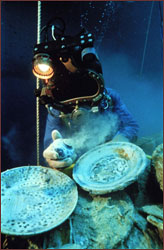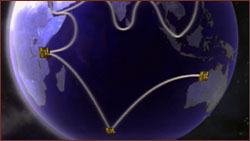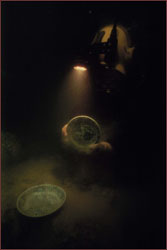 |
 |
|  Overseas trading of fine porcelain and other
objects began in China during the Song Dynasty.
Overseas trading of fine porcelain and other
objects began in China during the Song Dynasty.
|
Asia's Undersea Archeology
by Richard Gould
Seaborne commerce on a large scale in Asia dates to the Song Dynasty of
China (A.D. 960-1270). The Mongols in the succeeding Yuan Dynasty (ca.
1271-1368) went on to build even more ships on a grand scale, and during his
stay at the imperial court from 1275 to 1292, Marco Polo described four-masted,
seagoing merchant ships with watertight bulkheads and crews of up to 300. Early
in the Ming Dynasty (1368-1644), an expansion of seaborne trade took place with
the construction of an immense treasure fleet—reported to consist of 317
ships when it was assembled in Nanjing in 1405—that made trading cruises
throughout the Indian Ocean and the China seas (see Ancient Chinese
Explorers).
Ming seaborne commerce declined rapidly during the mid-15th century as a result
of conflict between the court and the merchants over control of the trade. The
emperor eventually declared the construction of any ship with more than two
masts a capital offense, authorized the destruction of all oceangoing ships and
the arrest of merchants who sailed them, and declared it a crime even to go to
sea in a multimasted ship.
Shipbuilding in the Song, Yuan, and Ming
Although shipwreck archeology is relatively new in Asia, important finds are
pointing the way toward the broader use of archeological evidence relative to
the documentary history of this era of Chinese maritime expansion. One cannot
always assume the documents to be detailed or accurate. As the English maritime
historian G.R.G. Worcester pointed out,
No writer of nautical experience has described these vessels [large ships of
the Mongol Dynasty] or provided us with information on which reliance can be
placed. Writers on shipping were, or seemed to be, practically unknown in those
days; the few that refer to [shipping] are so inaccurate and laconic, or both,
that their works have little real value, and so everything relating to the
ships of the period is in a great degree a matter for conjecture.
 Ming merchants sailed as far as Africa to trade goods.
Ming merchants sailed as far as Africa to trade goods.
|
|
No less an authority than the historian of technology Joseph Needham shared
this view. Needham pointed out that "systematic nautical treatises did not
arise in Chinese culture, or at least did not get into print." Furthermore,
European observers in medieval-era Chinese ships, including Marco Polo, were
characteristically impressed by their seaworthiness but at the same time
described them in Eurocentric terms on the basis of what they lacked—such as
keels, sternposts and stemposts, centerline rudders attached to the sternpost,
and masts that were not positioned along the ship's longitudinal centerline.
Often the interpretation based upon such observations was that Chinese
ship-building evolved in isolation from the rest of the world, especially from
the West. "As in so many other areas of activity," wrote maritime archeologist
Keith Muckelroy, "the craftsmen of China developed their own designs and
techniques, owing little if anything to outside influences and having
surprisingly little impact on ideas in neighboring lands."
It remains to be seen how isolated Chinese shipbuilding was during its zenith
in the Song, Mongol (Yuan), and Ming Dynasties, but it seems appropriate here
to remind archeologists to be wary of the fallacy of affirming the consequent.
That is, archeologists have a tendency to assume the very thing they should be
trying to find out. Most often this takes the form of the discovery of
something in the past to prove information derived from historic texts or
present-day observations.
Instead of assuming cultural isolation on the part of historic Chinese
shipbuilders and sailors, perhaps we should be using archeological evidence to
find out whether this was the case. The Australian maritime archeologist Jeremy
Green points out that following the imperial ban on overseas voyaging during
the Ming Dynasty, shipping increased along China's inland waterways and coasts.
This suggests that 19th- and early 20th-century
historical accounts of later Chinese ships were biased toward shallow-water
craft intended for use on canals, rivers, and close to shore—quite a
different maritime tradition from this earlier period in Chinese
history.
|  Gould argues that scholars should use
archeological evidence to prove or disprove the validity of historical
accounts, not vice versa.
Gould argues that scholars should use
archeological evidence to prove or disprove the validity of historical
accounts, not vice versa.
|
The Quanzhou wreck
The best archeological evidence available so far for this period comes from the
wreck found during canal dredging in 1973 of a large ship buried in muck at
Houzhou. Houzhou lies about six miles from Quanzhou, an important Song trading
port in what is now Fujian Province. In a series of reports, People's Republic
of China archeologists excavated and reported on the hull remains of the
Quanzhou ship, which are now on display at the Overseas Communications Museum
at Quanzhou.
The ship was about 114 feet long by 32 feet wide, with a displacement of
roughly 375 tons. The archeologists found more than 500 copper coins associated
with the wreck, 70 of which were minted during the Southern Song period (ca.
1127-1279), with the latest ones dating to 1272. The ship probably sank soon
after that date.
Associated with the ship remains were about 5,000 pounds of fragrant wood,
probably from either mainland or island Southeast Asia, and assorted materials
such as cowrie shells, ambergris, cinnabar, betel nut, pepper, and
tortoiseshell, all attributed to sources in Somalia—in other words, a
priority cargo. (Priority cargoes were processed and/or packaged in
archeologically identifiable ways that set them apart from unprocessed or
unpackaged bulk cargoes.) Although historical accounts of Chinese seaborne
commerce described organized trading expeditions, these archeological
associations could just as easily have resulted from tramping—that is, ships
not making point-to-point voyages but taking on and trading cargo at various
ports along the way—or even sustained cross-cultural trading partnerships.
The archeological team also found remains of supplies relating to the ship's
provisioning and operations, including faunal remains of possible food animals
(bird, fish, goat, pig, and cow) and dogs and rats (eaten, too?) as well as
plant remains of food items (coconuts, olives, lychees, peaches, and plums).
Portable artifacts included an axe, a wooden ruler, and a bronze ladle—all
useful items for maintaining the ship during its voyages—and assorted
celadon bowls, a stoneware wine jar, Chinese chessmen, glass beads, and other
personal items and tableware.
 Like the
Brunei wreck, on which this diver has uncovered a porcelain artifact, the
Quanzhou wreck held an enormous cargo of goods.
Like the
Brunei wreck, on which this diver has uncovered a porcelain artifact, the
Quanzhou wreck held an enormous cargo of goods.
|
|
Remains of the Quanzhou ship's hull were preserved up to the waterline,
permitting detailed study of important elements of the ship's construction. The
presence of transverse bulkheads agrees with early historical accounts such as
Marco Polo's, but in other respects, such as the claim for alternately stepped
masts and the absence of a keel, the archeological findings differ from
literary and ethnographic sources. The archeology of the Quanzhou ship presents
evidence of an oceangoing commercial vessel comparable in size to the largest
known European merchant ships of its time, which was engaged in trade of
priority goods around the Indian Ocean from East Africa to the southeast coast
of China. The archeological associations of both the ship's structure and its
contents are ambiguous about the conduct of the trade, beyond the general
implications of long-distance commerce and about whether the ship followed a
coastline route or engaged in true oceanic voyaging.
Continue: Evidence from South Korea
On China's China |
Ancient Chinese Explorers
Asia's Undersea Archeology |
Date the Dish |
Resources
Transcript |
Site Map |
Sultan's Lost Treasure Home
Editor's Picks |
Previous Sites |
Join Us/E-mail |
TV/Web Schedule
About NOVA |
Teachers |
Site Map |
Shop |
Jobs |
Search |
To print
PBS Online |
NOVA Online |
WGBH
© | Updated January 2001
|
|
|